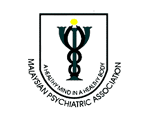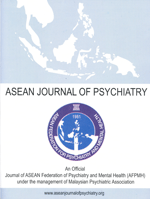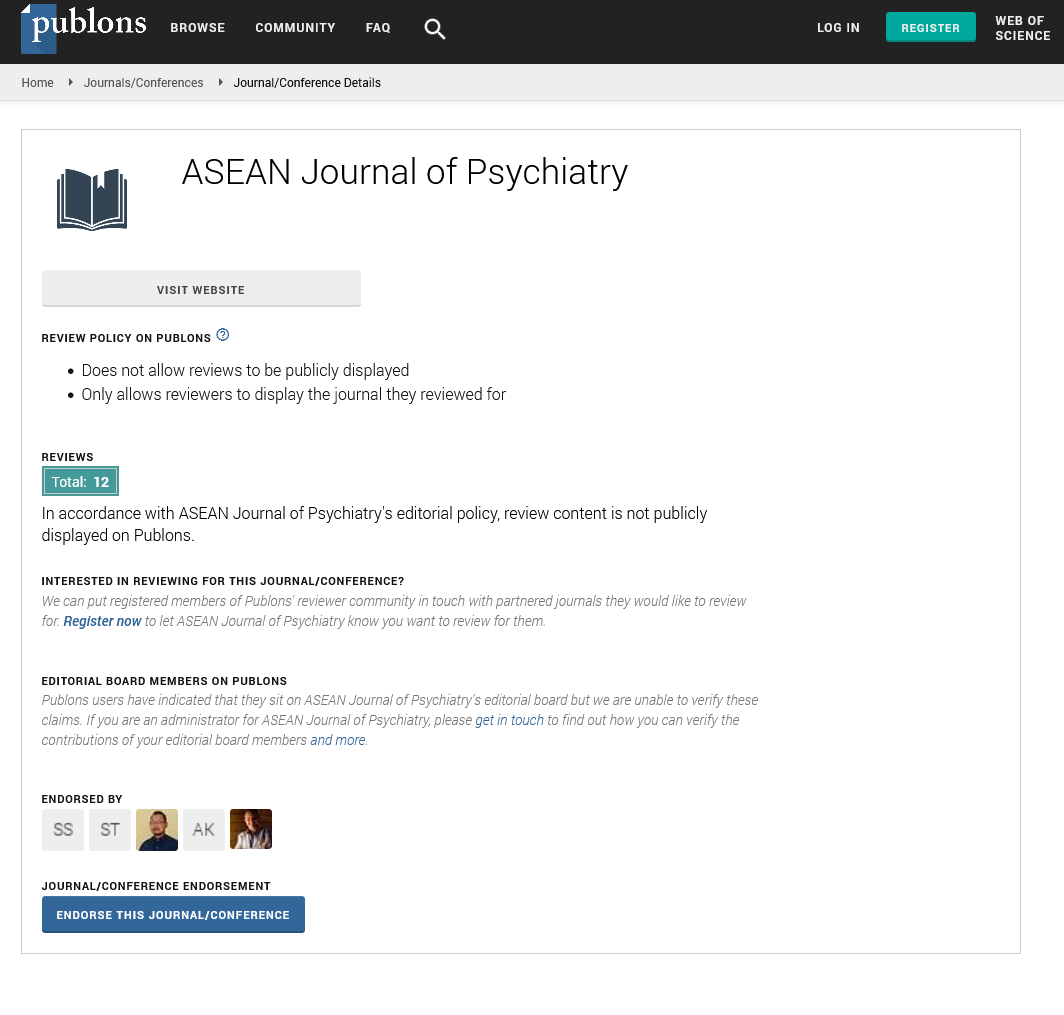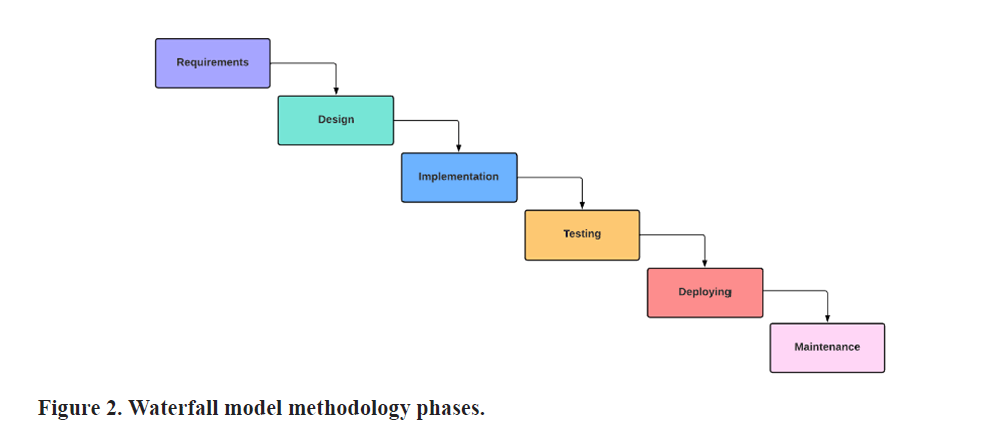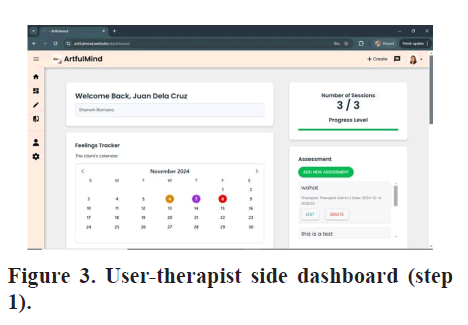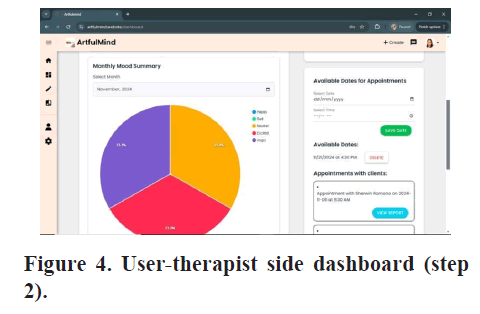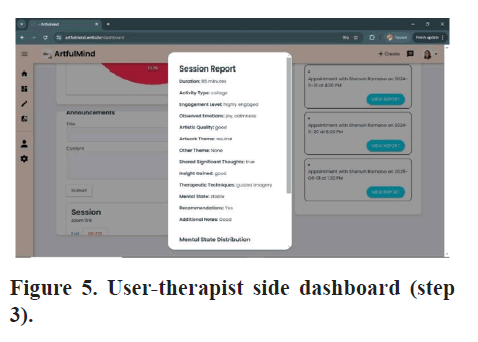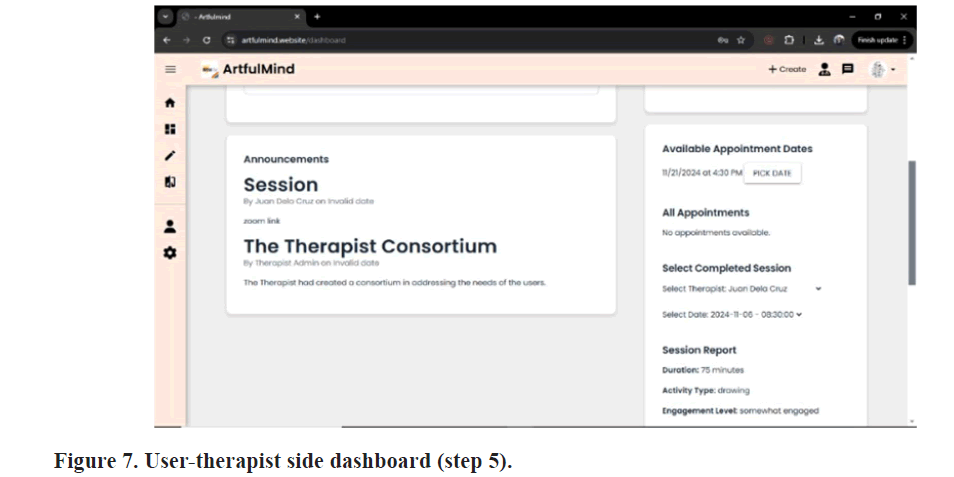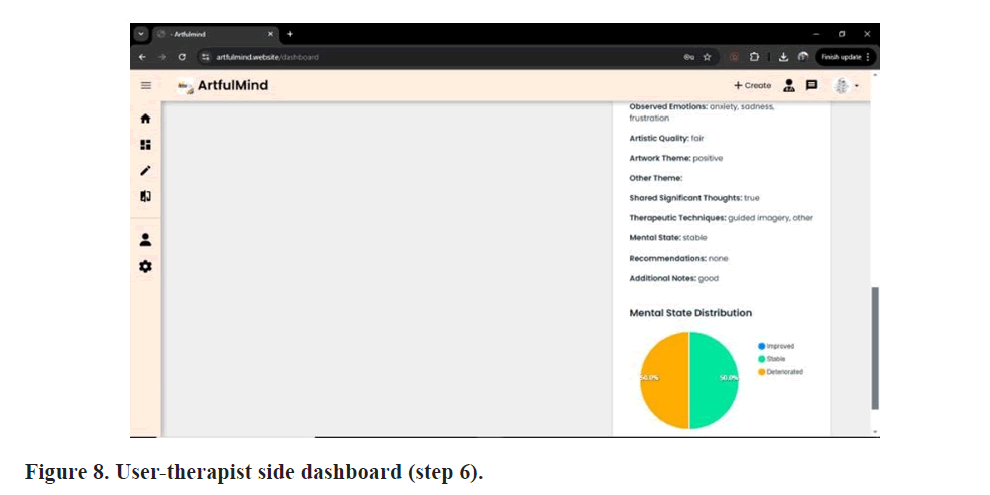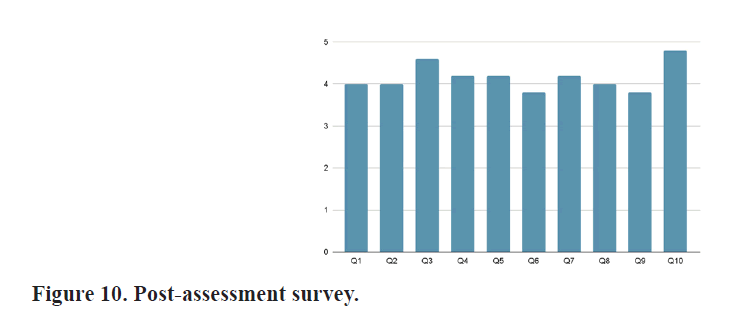Introduction
This section introduces the study, explaining
its purpose and objectives in creating a digital
platform to enhance mental wellness through art
therapy. It highlights the platform’s significance
in supporting stress management and emotional
well-being.
Background of study
In today’s rapidly evolving digital landscape,
e-health has revolutionized healthcare delivery,
offering unprecedented accessibility and
convenience [1]. E-Health encompasses diverse
services facilitated through the internet and related technologies, with telemedicine as one of
its earliest manifestations. This system shift has
ushered in patient conferences, informative health
websites and self-tracking systems, effectively
democratizing access to healthcare information
and services [2]. Among these, telemedicine has
emerged as a beacon of convenience, providing
a cost-effective gateway for individuals to access
healthcare services while emphasizing patient-
centered care [3].
This research explains combining digital
technology with art therapy within the e-health
framework to create a therapeutic digital platform
focused on mental well-being. As mental health
challenges like stress, anxiety and depression become more prevalent, conventional therapies
may not always align with the demands of
modern life [4]. Consequently, this study seeks
to develop an innovative platform that uses art
therapy principles to facilitate self-expression,
self-discovery and emotional healing. This
digital platform, grounded in the therapeutic
power of creativity, aims to empower users to
navigate their emotions and contribute to their
mental health. Future research will examine the
platform’s theoretical foundations, development
and potentially transformative impact on mental
wellness.
Research problem
Highly engaged college students often face
significant stress and emotional challenges due
to academic pressures and heavy workloads. Yet,
there are limited accessible resources tailored
to help them manage these demands effectively.
Traditional therapy options may not align with
their schedules or preferences and many struggle
to find tools that allow for emotional expression
in a way that feels natural and non-intrusive.
The lack of a flexible, creative digital solution
that integrates therapeutic practices specifically
designed for stress management among highly
productive students highlights the need for an
innovative approach that supports mental wellness
while accommodating their busy lifestyles.
Objectives of the study
The main objective of this study is to develop a
digital platform that promotes mental wellness
through personalized art therapy. Specifically, it
aims to: To develop a platform integrating digital
tools with art therapy for activities like free
drawing, collage making and mindful coloring
to support emotional healing. To create a mental
health platform offering personalized therapeutic
journeys, collaboration with professionals and
access to resources, communities and educational
content. To assess the effectiveness of a tech-driven
art therapy platform in improving mental health
and emotional stability. To evaluate the platform’s
impact on stress reduction and mental well-being
through user feedback and data analysis.
Research question
How does an integrating digital technology with
the therapeutic aspects of art therapy contribute
to reducing stress and improving overall mental
well-being?
Scope and delimitations
The study aims to understand the fundamental
principles of art therapy and its impact on
alleviating stress among individuals aged 18
years to 24 years, explicitly targeting highly
engaged college students. It will focus on free
drawing, collage making and mindful coloring to
manage stress and promote personal development.
Throughout the Academic Year 2023-2024,
the study seeks to deliver a tailored therapeutic
experience fostering self-discovery and emotional
revitalization.
The scope includes developing a web-based
digital platform that integrates technology with
art therapy and provides a support system for
emotional healing while considering factors
like internet connectivity, digital literacy and
device accessibility. While the primary focus is
stress reduction, the study acknowledges other
contributing factors to mental well- being that
may warrant further study.
Delimitations include limiting the platform
deployment to a website format, with future
research potentially exploring other digital
platforms or access methods. The study recognizes
that the influence of technology-driven art therapy
may vary across different individuals and cultural
contexts. The technological framework involves
using Laravel, HTML, CSS, Vue 3, Inertia
JS, MySQL, Node.js, Axios.js and Tailwind
CSS, with comprehensive testing to ensure the
platform’s functionality, security and readiness for
deployment.
Related terms
The following principles provide significant
subjects which associate healthcare, technology
and mental well-being.
Art therapy: Art therapy is a widely utilized
intervention primarily aimed at addressing
mental illnesses and facilitating the management
of psychosocially challenging behaviors [5].
Additionally, it has been observed to contribute
to the deceleration of cognitive decline and
the improvement of overall quality of life. The
utilization of art therapy has garnered recognition
as a valuable modality for facilitating selfexpression,
promoting mental well-being and
cultivating positive interpersonal connections.
E-health: E-health is a field that uses advancements in technology within healthcare
systems to enhance the provision of services
and facilitate the advancement of health [6]. The
achievement is facilitated through the utilization of
electronic means, such as the internet and mobile
devices, which enable the exchange of health-
related information between healthcare consumers
and providers. The e-health systems within the
healthcare sector have demonstrated significant
advancements in the areas of data transmission,
access to critical information and the facilitation
of informed medical decisions.
Mental health: Mental health refers to the state
of one’s psychological and emotional well-being,
characterized by the absence of mental disorders
and the presence of sufficient adaptation skills.
This is typically manifested through a sense of
self-acceptance, good attitudes towards others and
the ability to effectively cope with the challenges
of everyday life [7].
Mental well-being: Mental well-being significantly influences various aspects of our daily existence. This encompasses various aspects of human behavior, such as the formation of social connections and engagement in social activities, the implementation of stress management strategies and the decision-making processes employed in reaction to these external influences [8]. This pertains to individuals who do not experience mental illness. Additionally, the program places emphasis on individuals who have the potential to enhance their personal growth and strive towards a more purposeful existence.
Digital technology: Digital technologies
encompass several components such as
the Internet of Things (IoT), advanced
telecommunication networks, big-data analytics
and Artificial Intelligence (AI) utilizing deep
learning techniques and block chain technology
[9]. The relationship between the proliferation of
the Internet of Things (IoT) in healthcare settings
and the establishment of a highly interconnected
digital ecosystem is significant. This integration
allows for the collection of real-time data on a
large scale, which can subsequently be utilized
by Artificial Intelligence (AI) and deep learning
systems to analyze healthcare trends, model risk
associations and make predictions about outcomes.
Review of related literature
The below mentioned types encompass
diverse applications of art therapy, including its effectiveness in reducing academic stress,
integrating digital technology in therapeutic
practices and supporting psychological well-being
through online group sessions, highlighting its
ability across multiple challenges and scenarios.
The effectiveness of art therapy to reduce
academic stress among students during online
learning: The study investigates the effectiveness
of art therapy in reducing academic stress among
academically challenged adolescents experiencing
increased stress during the transition from in-person
to online learning due to the COVID-19 pandemic
[10]. This study aims to evaluate the potential
impact of art therapy on reducing academic stress,
developing student motivation and enhancing
their capacity to meet assignment deadlines. The
study utilizes a standardized academic stress
scale instrument to assess the effects of the art
therapy intervention. The research uses a quasi-
experimental design and applies an experimental
methodology. The study’s participants consist of
students who experience significant academic
pressure. The instrument employed in this study
was the academic stress scale.
The research participant actively participated in
the data-gathering process. Art therapy tools are
utilized in direct interventions that adhere to the
COVID-19 transmission prevention strategy.
The statistical software program developed by
Jeffreys, known as Jeffrey’s Amazing Statistics
Program, was employed to analyze study data. The
study’s findings indicated that those who engaged
in art therapy exhibited a noteworthy decrease in
academic stress levels, with an average drop of
47,800 units. This reduction was determined to be
statistically significant. This finding suggests that
art therapy is a viable and productive method for
reducing academic stress. Moreover, art therapy
enhances the process of emotional exploration
and aids in the identification of the underlying
causes of academic stress among individuals who
participate in this therapeutic intervention.
Art therapy in the digital world-an integrative
review of current practice and future directions: The study employed an integrated review
methodology to examine the utilization of digital
technology within art therapy, focusing on peer-
reviewed literature [11]. The background section
of the study emphasized the growing prevalence
of digital technologies in psychotherapy and their
potential to expand the scope of art therapy. The
study investigated how art therapists actively
interact with digital technology and studied the feasibility of its secure integration into therapeutic
practices. The research process encompassed
screening over 400 records and analyzing 12
papers presenting empirical findings about digital
technology utilization in art therapy. The study’s
results revealed repeating patterns, encompassing
the advantages and drawbacks of using digital
technology in therapeutic practices, ethical
considerations, limitations of technology and
the potential impact on the therapeutic alliance.
The research findings indicate a discernible
inclination toward utilizing digital technology
within art therapy. This emerging trend presents
both advantageous prospects and potential
obstacles that require thorough deliberation and
examination. There is a need for additional study
and open dialogues to investigate the potential of
technology in augmenting the scope of art therapy
while simultaneously upholding the fundamental
ideals of the profession and ensuring the safety of
clients.
Effects of online group art therapy on
psychological distress and quality of life after
family bereavement: In COVID-19 pandemic: This research investigated the impact of online
group art therapy on adults who have experienced
the loss of family members [12]. The study
employed three assessment tools to measure
levels of depression, grief and quality of life
within a randomized controlled trial. Among the
thirty-six participants who had encountered the
death of a family member, twenty were allocated
to the experimental group, which engaged in
online group art therapy consisting of eight onehour
sessions held once a week. The remaining
sixteen participants constituted the control
group, receiving no intervention. Results from
the experimental group indicated a reduction in
depression and grief and an enhancement in their
overall quality of life. These findings suggest
that online group art therapy holds promise in
supporting adults in coping with the loss of family
members, alleviating psychological distress and improving their overall quality of life (Figure 1).
Synthesis of findings and research gap
The reviewed studies confirm art therapy’s
effectiveness in reducing academic stress and
enhancing emotional well-being. For instance,
research on art therapy during online learning
demonstrated significant stress reductions and
improved motivation and emotional processing
among students facing academic pressures [10].
Similarly, digital technology’s integration within
art therapy has shown promise in expanding
accessibility and flexibility, which are particularly
valuable for those with restrictive schedules,
like college students [11]. Other studies indicate
the potential of online group art therapy in
alleviating psychological distress, showcasing its
applicability in various high-stress environments,
from academic to personal losses [12].
However, these studies also reveal a critical gap.
While digital art therapy shows potential, there
is a lack of targeted digital solutions designed
specifically for college students, balancing
demanding workloads with the need for accessible
mental health resources. This gap, particularly
the need for a platform that integrates creative
therapeutic practices in a flexible digital format,
points to the need for a tool tailored to college
students’ unique challenges. Thus, this research
seeks to bridge this gap by developing a digital art
therapy platform that supports stress management
and overall mental wellness among highly
productive students meeting them where they are
with an innovative and practical approach.
Materials and Methods
Figure 2 illustrates the researcher’s use of the
Waterfall Model as the framework for developing
the art therapy website, a structured approach
selected due to its suitability for projects with
clearly defined requirements and sequential
processes.
Waterfall model
The Waterfall Model’s linear and step-by-step
nature guarantees disciplined progression,
ensuring that each phase is completed in its
entirety before transitioning to the next. This
approach minimizes the risk of overlooked
details and promotes a thorough, well-organized
development process. The process begins with
the requirements phase, where researchers gather
and document the therapeutic goals, user needs
and technical specifications through consultations
with mental health professionals and potential
users to identify key features like digital art tools,
privacy requirements and accessibility standards.
In the design phase, they develop the system’s
architecture, interface and user experience by
creating detailed blueprints, wireframes and
prototypes, focusing on an intuitive interface
that supports therapeutic processes. The
Implementation phase translates the design into
a functional system through coding, integrating
components such as user account management
and secure data storage while adhering to
documentation standards. During the Testing
phase, the website is rigorously evaluated for
functionality, usability and reliability, with
identified issues resolved to ensure quality. The
deployment phase follows, making the platform
accessible to the target audience and optimizing
performance for real-world use.
Finally, the Maintenance phase involves ongoing
monitoring and iterative improvements based
on user feedback to keep the platform effective
and relevant, incorporating new features and
addressing evolving needs. By adopting the
Waterfall Model, the researchers adhered to a
methodical and structured development approach,
resulting in a robust, user-centric art therapy website that is well-equipped to deliver its
intended therapeutic benefits.
Research design
A mixed method research design, a convergent
parallel method was employed, focusing on
objective measurements and statistical analysis
to collect numerical data about the observed
phenomenon of utilizing the website under this
study [13]. Statistical data analysis will be used
to prove the website’s efficacy and answer the
research question. The responses gathered from
participants will be used to evaluate the features
and contents of the proposed website.
System design
The system design phase is vital in developing
the personalized art therapy platform, structuring
its core components for a seamless, user-friendly
experience. This phase includes creating intuitive
UI and comprehensive system documentation,
emphasizing both functionality and the integration
of therapeutic principles. This ensures the
platform is engaging, emotionally supportive and
aligns with the project’s goal of enhancing mental
wellness.
The therapist dashboard offers a user-friendly
interface for managing client sessions and
tracking mental health progress. Key features
include a “Feelings Tracker” for logging
emotions, a ‘Progress Level’ tracker for session
completion and a “Monthly Mood Summary”
chart to visualize emotional trends. Therapists
can post updates, share announcements and add
session notes to maintain thorough records and
consistent communication. These tools enable
personalized care and streamline the therapeutic
process (Figure 3).
The therapist dashboard is designed to streamline
session management and client tracking. It
includes a personalized greeting that displays the
therapist’s name, a progress tracker showing the
number of sessions completed by the client and
a progress bar for quick reference. The “Feelings
Tracker” features an interactive calendar with
color-coded markers indicating the client’s logged
emotions on specific dates, enabling therapists
to monitor emotional trends over time. The
assessment section allows therapists to add, edit
or delete evaluations, with timestamps ensuring
accurate and organized record-keeping. The header
provides navigation options and profile access,
offering a user-friendly interface for managing
therapeutic activities efficiently (Figure 4).
The interface includes key features for monitoring
client moods and managing appointments. The
left panel displays a pie chart summarizing the
client’s emotional states for the selected month,
with color-coded segments representing moods
such as happy, sad, neutral and angry, providing
a quick overview of emotional patterns. The right
panel offers tools for appointment management,
including a date picker to select and save
available dates and a “Delete” button to remove
appointments. Below the date picker, a list of
upcoming appointments shows the therapist’s
and client’s names and session times and a “View
Report” button allows access to detailed session
records. This layout efficiently combines data visualization and appointment management,
supporting therapists in tracking client progress
and managing their schedules (Figure 5).
The interface displays the “Session Report”
summarizing a therapy session. Key metrics
include the session duration, activity type,
engagement level and observed emotions. The
report also assesses artistic quality and includes
insights into themes, significant thoughts and
applied techniques. A recommendation status and
the client’s mental state are noted. The dashboard
provides tools to view past session reports, track
client progress and manage appointments.
The Artful Mind user dashboard mirrors aspects of
the therapist’s interface but is personalized for an
engaging user experience. It greets users by name,
developing connection and encouraging active
participation. A progress tracker visually displays
completed therapy sessions, motivating users
and highlighting achievements. The Feelings
Tracker and Mood Selection tools let users log
daily emotions with intuitive emoji buttons, which
mark the date on an interactive calendar to reveal
emotional patterns over time. The Assessment
section provides personalized feedback, offering
motivational insights and suggestions. A recent
announcements area keeps users informed about
updates, developing community connection and
continuous engagement (Figure 6).
The client dashboard provides an overview
of client engagement and session tracking. It
includes a “Feelings Tracker”, allowing clients
to log daily emotional states, visually represented
on a calendar. A progress summary indicates
the client has completed the scheduled sessions.
The “Assessment” section displays feedback or
evaluations from therapists, including session
dates and brief comments. The interface is
designed to help clients monitor their mental
health and review therapy outcomes (Figure 7).
This interface allows users to manage
appointments, access session reports and view
announcements. The “Announcements” section
displays updates from the therapist. Users can
review available appointment dates and schedule
sessions directly. The “Session Report” section
provides details of completed sessions, including duration, activity type and engagement level.
The dashboard is structured to help clients stay
informed about their therapy progress and manage
their participation effectively (Figure 8).
The displayed client-side dashboard organizes and
visualizes data related to mental state evaluation
through artistic inputs. Key elements include
a pie chart summarizing the “Mental State
Distribution” with three categories: Improved,
stable and deteriorated. The right-hand panel
lists critical metadata, including observed
emotions, artistic quality, thematic aspects and
therapeutic techniques utilized. The dashboard
highlights mental state status and additional
recommendations or notes. The layout supports
data-centric assessments, emphasizing clarity and
functionality in tracking the mental health of the
patient and their therapeutic outcomes.
Results and Discussion
This section presents the outcomes of functionality
testing performed on the developed system. These
results were obtained by executing rigorously
designed test scripts, aimed at verifying
the system’s intended functionalities. The
researchers organized the testing procedures
into checklists, which acted as detailed guides
to assess the system’s performance in different
functional areas. This testing was carried out
prior to moving on to the usability testing with
the target respondents.
Functionality testing
Table 1 presents the functionality testing results
for the Artful Mind Web Application, focusing
on three main modules: Account management,
dashboard and activities. In the account
management module, essential functionalities
such as account registration and authentication for
both users and therapists were tested.
Table 1. Functionality testing results for the artful mind web application.
| Test descriptions |
Expected results |
Test results (pass/fail) |
| Account management |
4 |
Pass (100%) |
| Dashboard |
7 |
Pass (100%) |
| Activities |
8 |
Pass (100%) |
| Total |
19 |
100% |
This module passed all four expected tests,
resulting in a 100% success rate, confirming
that both users and therapists can successfully
register and authenticate their accounts. The
Dashboard module was evaluated for key features,
including “Progress Level”, “Feelings Tracker”,
“Assessment” and “Announcement”. With seven
expected results, all tests passed, demonstrating
that therapists can update users on their progress,
monitor emotional patterns, assess user sessions
and post announcements as needed. This module
also achieved a 100% success rate.
The Activities module was tested to ensure both
users and therapists could fully utilize the “Free
Drawing” and “Coloring/Collage” tools. Covering
eight expected results, all tests passed, confirming
complete accessibility and functionality for both
activities. Overall, the application achieved a
100% pass rate across all 19 expected results,
verifying that each module performs as intended
and supports the necessary user interactions within
the Artful Mind Web Application.
Usability testing
The research utilized a quasi-experimental and
quantitative approach to evaluate the system’s
usability. A pre-designed survey questionnaire,
based on the Likert Scale, was administered
to the selected participant’s three psychology
professionals and five highly productive or
engaged college students assigned to the
experimental group [14]. The questionnaire
included a set of standardized statements pertaining
to usability, which participants evaluated using
a Likert Scale [15]. The scale ranged from
one to five, corresponding to the following
levels of agreement: (1) Strongly Disagree, (2)
Disagree, (3) Neutral, (4) Agree and (5) Strongly
Agree [16]. Furthermore, the questionnaire
was divided into four sections: Learnability,
efficiency, memorability and satisfaction. Each
of them aligned with different features of the
developed system [17]. The survey was conducted
simultaneously with the system’s implementation
as part of the experimental intervention.
Table 2 interprets measurements on a 5-point
Likert scale, categorizing responses based
on descriptive labels, numerical values and
corresponding intervals. Each level on the
Likert scale is associated with a specific range of
values, indicating the intensity of agreement or
disagreement. The scale ranges from “Strongly
disagree” with a value of 1 and an interval of
1.00-1.80, to “Strongly agree” with a value of 5
and an interval of 4.21-5.00. Values of 2 and 4
represent “Disagree” (1.81-2.60) and “Agree”
(3.41-4.20), respectively, while a value of 3
represents a “Neutral/Uncertain” stance within
the interval of 2.61-3.40. For the primary analysis,
the mean values derived from the descriptive
statistics were interpreted as follows: A range
of 1.00-1.80 indicates Strongly Disagree, 1.81-
2.60 indicates “Disagree”, 2.61-3.40 reflects a
“Neutral response”, 3.41-4.20 indicates Agree and
4.21-5.00 represents “Strongly agree” [18]. This
interpretative framework aids in understanding the
distribution and overall sentiment of responses.
Table 2. Functionality testing results for the Artful Mind web application interprets measurements.
| Likert-scale description |
Likert-scale |
Likert scale interval |
Interpretation |
| Strongly disagree |
1 |
1.00-1.80 |
Negative |
| Disagree |
2 |
1.81-2.60 |
Negative |
| Neutral/uncertain |
3 |
2.61-3.40 |
Positive |
| Agree |
4 |
3.41-4.20 |
Positive |
| Strongly agree |
5 |
4.2-5.0 |
Positive |
Table 3 comprehensively evaluates various
system features, focusing on key usability metrics:
Learnability, efficiency, memorability and
satisfaction. The account management features
scored exceptionally well across all metrics,
with a learnability rating of 4.8, efficiency at 5,
memorability at 4.6 and satisfaction at 5. These
results suggest that users find this feature highly
intuitive, efficient and satisfying. Similarly, the
art therapy activities feature exhibited strong
usability, receiving a learnability, efficiency and
memorability score of 4.4 and satisfaction at 4.8.
While the results indicate that users generally find
the feature easy to learn and remember, there is
room for improvement in enhancing memorability.
The Assessment with professional feature also
performed well, though it scored slightly lower
than the other features, with a learnability rating
of 4.2, efficiency of 4.6, memorability at 4.2 and
satisfaction at 5. This suggests that while users are
highly satisfied with the feature, its memorability
could be further improved. Lastly, the overall
system received positive feedback, with ratings
of 4.4 for learnability and efficiency, 4.6 for
memorability and 5 for satisfaction, reflecting
an overall favorable user experience across the
system.
Table 3. Usability test results per feature for users.
| Features |
Learnability |
Efficiency |
Memorability |
Satisfaction |
| Account management |
4.8 |
5 |
4.6 |
5 |
| Art therapy activities |
4.4 |
4.4 |
4.4 |
4.8 |
| Assessment with professional |
4.2 |
4.6 |
4.2 |
5 |
| Overall system |
4.4 |
4.4 |
4.6 |
5 |
Table 4 presents the usability test results for
therapists, assessing key system features based
on essential usability factors: Learnability,
efficiency, memorability and satisfaction. The
results indicate that therapists rated the account
management feature with a perfect score of 5 for
both learnability and efficiency, demonstrating
that the feature is highly intuitive and efficient.
The memorability score of 4.67 suggests that
therapists find it relatively easy to recall how to
use the feature, while the perfect satisfaction score
of 5 reflects high user approval. In comparison,
Art Therapy Activities received slightly lower
scores, with 4 for both learnability and efficiency,
indicating that while the feature is relatively easy to learn and efficient, there is room for improvement.
Memorability was rated higher at 4.67, suggesting
that recalling how to use the feature is not an issue,
but the satisfaction score of 4.33 highlights some
potential areas for enhancing user satisfaction.
Lastly, the overall system was rated positively,
with a learnability score of 4.67, efficiency of 4.0,
memorability of 4.33 and a satisfaction score of
5. While the overall user experience is strong,
improvements in efficiency and memorability
could further enhance the system’s usability.
Table 4.Usability test results per feature for therapist.
| Features |
Learnability |
Efficiency |
Memorability |
Satisfaction |
| Account management |
5 |
5 |
4.67 |
5 |
| Art therapy activities |
4 |
4 |
4.67 |
4.33 |
| Overall system |
4.67 |
4 |
4.33 |
5 |
Effectiveness of artful mind web application
To align with the study’s objective and
methodology, comprehensive surveys and indepth
interviews were conducted. The researchers
selected participants to represent two distinct
perspectives: Expert opinions from psychology
professionals and insights from highly productive
or engaged students. The subsequent analysis,
presented in the following figure, studies the
evaluation results, focusing on the system’s
effectiveness in alleviating stress among these
students. The findings are used to gauge how
the digital platform performs in supporting the
mental health of highly productive students.
This approach allows the study to gather both
professional view points and personal experiences
while emphasizing the strengths and limitations
of the digital art therapy system, particularly
in its capacity to address stress in a manner that
resonates with this specific group of students (Figure 9).
The researchers conducted a pre-survey with
the assistance of a psychology professional to
determine the level of stress and the difficulty in
expressing emotions among highly productive
or engaged college students. The purpose of the
pre-survey questions under the “Stress” category
is to gauge the participant’s current stress levels
and identify its sources. The statements are
designed to study how stress manifests in their daily lives and how effectively they cope with it.
By addressing feelings of overcome, mood swings
and difficulties in managing stress, the survey
aims to provide a baseline understanding of the
participant’s mental and emotional state. This
understanding will help determine the extent to
which stress impacts their academic performance
and overall well-being, thus serving as a foundation
for developing appropriate support or intervention
strategies. Moreover, the “Difficulty Expressing
Emotions” category is focused on understanding
participant’s ability to articulate and communicate
their emotional experiences.
The statements assess whether participants feel
inhibited when describing emotions, struggle
to convey what they are feeling or tend to avoid
emotional discussions altogether. This category
aims to identify potential barriers in emotional
communication, which could lead to feelings of
isolation or misunderstanding. The results from
this survey can guide the development of activities
or workshops aimed at improving emotional
literacy and enhancing participants’ capacity
to express them more clearly and confidently.
The overall stress level among the respondents
is considerably high, with a total average score of 4.24 out of 5. The results indicate that most
participants are experiencing significant stress,
largely driven by academic pressures and a feeling
of being stressed by their responsibilities, both of
which scored 4.4.
Moreover, students reported difficulties in managing
their stress effectively and are experiencing mood
swings or irritability, both scoring 4.2. The results
suggest that the respondents are struggling with
their current workload and academic demands,
which contribute significantly to their stress
levels. Subsequently, the students also reported
moderate to high difficulty in expressing their
emotions, with an average score of 4.08 out of 5.
The students expressed challenges in putting their
emotions into words and talking about them, with
a score of 4.2 in several related items. A slightly
lower score of 3.8 was recorded for the feeling
of being misunderstood, indicating that while
some students find it hard to communicate their
emotions, it is not always perceived as a major
barrier. The consistency of high scores suggests
that most of the students avoid talking about
their feelings due to the inability to express them,
which may contribute to feelings of isolation or
frustration (Figure 10).
The post-survey was conducted after respondents
had undergone several art therapy sessions to assess
the impact on their stress levels and emotional
expression abilities. The focus was on measuring
improvements in managing stress and their ability
to communicate emotions more effectively.
Participants were asked to reflect on changes in
their emotional well-being, self-awareness and
stress management since the initial survey. The
post-survey aimed to capture how engaging in
art therapy influenced their emotional processing,
stress resilience and overall psychological health,
providing insights into the effectiveness of art
therapy as a tool for personal growth and mental
wellness.
The survey results indicate a generally positive
impact of art therapy on college student’s
emotional and psychological well-being. With an
average rating of 4 out of 5, individuals report that
art therapy has helped them better understand their
emotions. Most respondents reported high levels
of satisfaction, with an average score of 4 for
understanding and gaining control over emotions.
Subsequently, participants felt that art therapy
significantly reduced stress (4.6) and provided a
safe environment for expressing difficult emotions
(4.2). Positive mood changes were commonly
noted (4.2), alongside improved self-esteem and
confidence (3.8). A sense of deeper connection
with one’s inner self (4.2) and the ability to
manage negative thoughts (4) was also frequently
reported. Although some rated the development
of new coping strategies slightly lower (3.8), the
overall emotional and psychological benefits of art
therapy were highly regarded, with an impressive
score of 4.8 out of 5, suggesting its effectiveness
in supporting mental wellness. These results
affirm art therapy as a valuable tool in emotional
regulation, stress relief and self-exploration.
Methodological approach and process
In developing a digital platform for art therapy, a structured, stepwise approach was applied using
the Waterfall Model methodology to ensure
thorough planning, reliability and measurable
outcomes. Each phase contributed strategically
to the platform’s potential for supporting mental
wellness. During the Requirements Phase, input
was collected from mental health professionals
and potential users, particularly college students,
to establish therapeutic goals, user needs and
essential features. This included incorporating
personalized art therapy activities-such as free
drawing, collage making and Mindful coloring
aimed at supporting emotional expression and
reducing stress.
The subsequent design Phase involved creating
detailed blueprints and wireframes to ensure
an intuitive, user-centered interface. Design
considerations prioritized essential features
such as user account management, professional
collaboration tools and access to supportive
resources, all of which are critical for providing a
holistic mental health environment. These designs
were then translated into functional modules in
the implementation phase, where each component
was rigorously tested for reliability and usability.
Functionality testing confirmed that important
features, including account management,
dashboards and art therapy activities, consistently
performed as intended, achieving a 100% pass
rate across all test cases. Usability testing yielded
high scores in areas such as learnability, efficiency
and user satisfaction, underscoring the platform’s
alignment with user needs.
The design choices made in this development
process significantly contributed to positive
outcomes. A user-centered interface, combined
with popular art therapy tools, developed
high engagement and intuitive navigation,
supporting users in achieving therapeutic benefits.
Additionally, the platform’s collaboration features
and access to mental health resources likely
enhanced its perceived value, as reflected in high satisfaction scores. This systematic approach
validated that each platform aspect effectively
aligned with the study’s objectives, promoting a
positive and impactful user experience.
Conclusion
The primary objective of this research was to
develop a digital platform aimed at reducing stress
and enhancing overall mental well-being through
art therapy, offering personalized expression and
therapeutic guidance for highly engaged college
students aged 18-24. The research successfully
developed a digital platform aimed at reducing
stress and enhancing mental well-being through
personalized art therapy. Findings from interviews,
functionality and usability testing showed that
integrating digital technology with art therapy
effectively supported emotional expression, stress
relief and overall wellness. The platform met its
primary objectives, achieving a 100% success rate
in both user and admin functionalities, confirming
its effectiveness in delivering personalized
therapeutic guidance.
The primary objective of this research was to
develop a digital platform aimed at reducing stress
and enhancing overall mental well-being through
art therapy, offering personalized expression and
therapeutic guidance for highly engaged college
students aged 18-24. The research successfully
developed a digital platform aimed at reducing
stress and enhancing mental well-being through
personalized art therapy. Findings from interviews,
functionality and usability testing showed that
integrating digital technology with art therapy
effectively supported emotional expression, stress
relief and overall wellness. The platform met its
primary objectives, achieving a 100% success rate
in both user and admin functionalities, confirming
its effectiveness in delivering personalized
therapeutic guidance.
Recommendations
The interview with the psychology professional
provides clear evidence that integrating digital
technologies with art therapy significantly
contributes to reducing stress and improving
overall mental well-being among highly engaged
college students. This emphasized that digital
art therapy enhances patient engagement by
offering a creative and pressure-free environment,
particularly appealing to students who benefit
from its flexibility. Its non-verbal nature allows
for emotional expression and processing, which
is especially valuable for individuals who struggle with verbal communication of emotions. Activities
like creating digital artwork were shown to lower
stress levels and promote calmness. Furthermore,
the therapy encouraged self-reflection and deeper
emotional understanding as students gained
insight into their feelings through their creations
and subsequent guided discussions. The findings
suggest that digital art therapy is a powerful tool
for managing emotional stress, supporting mental
health and developing self-awareness in highly
productive students.
References
- Filip R, Gheorghita Puscaselu R, Anchidin-Norocel L, Dimian M, Savage WK. Global challenges to public health care systems during the COVID-19 pandemic: A review of pandemic measures and problems. J Pers Med. 2022;12(8):1295.
[Crossref] [Google Scholar] [PubMed]
- Da Fonseca MH, Kovaleski F, Picinin CT, Pedroso B, Rubbo P. E-health practices and technologies: A systematic review from 2014 to 2019. Healthcare. 2021;9(9):1192.
[Crossref] [Google Scholar] [PubMed]
- Findyartini A, Hanum C, Kusumoningrum DA, Putera AM, Werdhani RA, et al. Cultivating patient-centered care competence through a telemedicine-based course: An explorative study of undergraduate medical student’s self-reflective writing. Front Public Health. 2023;11:1134496.
[Crossref] [Google Scholar] [PubMed]
- Malolos GZ, Baron MB, Apat FA, Sagsagat HA, Pasco PB, et al. Mental health and well-being of children in the Philippine setting during the COVID-19 pandemic. Health Promot Perspect. 2021;11(3):267-270.
[Crossref] [Google Scholar] [PubMed]
- Apoorva S, Choudhari SG, Gaidhane AM, Zahiruddin QS. Role of art therapy in the promotion of mental health: A critical review. Cureus. 2022;14(8):e28026.
[Crossref] [Google Scholar] [PubMed]
- Noor A. The utilization of e-health in the Kingdom of Saudi Arabia. Int Res J Eng Technol. 2019;6(09):11.
[Google Scholar]
- Merriam-Webster. Mental Health. In Merriam-Webster.com dictionary.
- Park SY, Andalibi N, Zou Y, Ambulkar S, Huh-Yoo J. Understanding student’s mental well-being challenges on a university campus: Interview study. JMIR Form Res. 2020;4(3):e15962.
[Crossref] [Google Scholar] [PubMed]
- Ting DS, Carin L, Dzau V, Wong TY. Digital technology and COVID-19. Nature medicine. 2020;26(4):459-461.
[Crossref] [Google Scholar] [PubMed]
- Zubala A, Hackett S. Online art therapy practice and client safety: A UK-wide survey in times of COVID-19. Int J Art Ther. 2020;25(4):161-171.
[Crossref] [Google Scholar]
- Park SR, Cha YJ. Effects of online group art therapy on psychological distress and quality of life after family bereavement: In COVID-19 pandemic. Arts Psychoth. 2023;82:101972.
[Crossref] [Google Scholar]
- Sajnani N, Mayor C, Tillberg-Webb H. Aesthetic presence: The role of the arts in the education of creative arts therapists in the classroom and online. Arts Psychoth. 2020;69:101668.
[Crossref] [Google Scholar] [PubMed]
- USC Libraries. Organizing Your Social Sciences Research Paper. 2020.
- Zalavadia, S. Complete Functional Testing Guide with Its Types and Example. 2024.
- Arai K, Kapoor S, Bhatia R, editors. Proceedings of the Future Technologies Conference (FTC) 2020, Volume 2. 2020.
[Google Scholar]
- Mohd F, Yahya WF, Jalil MA, Ismail S, Noor NM, et al. User Acceptance Testing (UAT) for the development and evaluation of an automated learning style detection system. AIP Conf Proc. 2019;2138(1).
[Crossref] [Google Scholar]
- Nikiforow N, Wagener S. The contextual effect of completion on the effectiveness of performance feedback. J Bus Econ. 2021;91(1):61-90.
[Crossref] [Google Scholar]
- Nyutu EN, Cobern WW, Pleasants BA. Correlational study of student perceptions of their undergraduate laboratory environment with respect to gender and major. Int J Educ Math Sci Technol. 2021;9(1):83-102.
[Google Scholar]
Citation: Artful Mind: Developing Mental Wellness through Art Therapy for Personalized Expression and Therapeutic Guidance ASEAN Journal of Psychiatry, Vol. 25 (10) December, 2024; 1-13.

